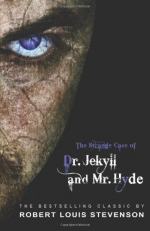|
|
Dr. Jekyll and Mr. Hyde Author/Context
Robert Louis Stevenson was born in Edinburgh, Scotland in 1850. His father, Thomas, was from a long line of civil engineers and his mother, Margaret Isabella, was a pastor's daughter and a loving Victorian housewife. Young Robert, or Lou, as they called him, was an only child. He grew up having to battle chronic illnesses, the worst being tuberculosis. Relegated to his home for most of his childhood, he was unevenly educated, but displayed an active, creative mind. He started writing and creating stories at an early age. And although his parents were strict Presbyterians, Stevenson's childhood nurse, Alison Cunningham, was a greater religious and literary influence in his early life. Her strong faith and hellfire stories formed Stevenson's preoccupation with sin and eternal damnation.
To please his father, Stevenson enrolled as an engineering student at Edinburgh University. But it was evident his love was in writing. Stevenson spent more time reading the romantic stories of Sir Walter Scott and Alexander Dumas. With the urging of some friends (and despite the disappointment of his father), Stevenson decided to pursue his desire to be a writer. Stevenson frequently took trips, both for health and pleasure. During one of these trips, he met Fanny Obsbourne, an American, ten years his senior, with two children and an estranged husband. Still, Stevenson fell madly in love, temporarily abandoning his writing career to travel all the way to California to propose to her. In 1880, they were married. To his pleasant surprise, his parents accepted her warmly. His father gave them a house in Bournemouth, where Stevenson became friends with William James, William Archer, John Sargent, and many other leading writers and artists of the time.
Despite his poor health, Stevenson resumed his writing career. Previously, he had published travel essays and short stories, but he turned to writing novels. In 1883, he published Treasure Island, a much beloved children's classic. One night, having been awakened amidst a frightful dream, Stevenson remarked to his wife, "I was dreaming a fine bogey tale." From this nightmare came the material for The Strange Case of Dr. Jekyll and Mr. Hyde. He worked on the first manuscript for three straight days. After reading it to his wife, he threw the draft into the fireplace. Stevenson immediately worked on a second version and came up with his little masterpiece. The Strange Case of Dr. Jekyll and Mr. Hyde, was published in 1886 and became an instant popular and critical success. It was immediately followed by the publication of Kidnapped later that same year. In 1888, came Black Arrow, his last popular book. On December 3, 1894, Stevenson died of a brain hemorrhage on the island of Somoa.
Stevenson's heritage as a writer can be seen in the works of authors such as Oscar Wilde, Joseph Conrad, Jack London, G.K. Chesterton, and George Bernard Shaw. Stevenson's adventurous life as a Bohemian, world traveler, and Victorian rebel has also been a subject of great interest to many literary scholars. Undoubtedly, Stevenson is placed among the greatest English prose storytellers of the 19th century.
Bibliography
Butts, Dennis. R. L. Stevenson. New York: Henry Z. Walck, Inc., 1966.
McLynn, Frank. Robert Louis Stevenson: A Biography. New York: 1993.
Stevenson, Robert L. Dr. Jekyll and Mr. Hyde. New York: Penguin Putnam, Inc., 1978




